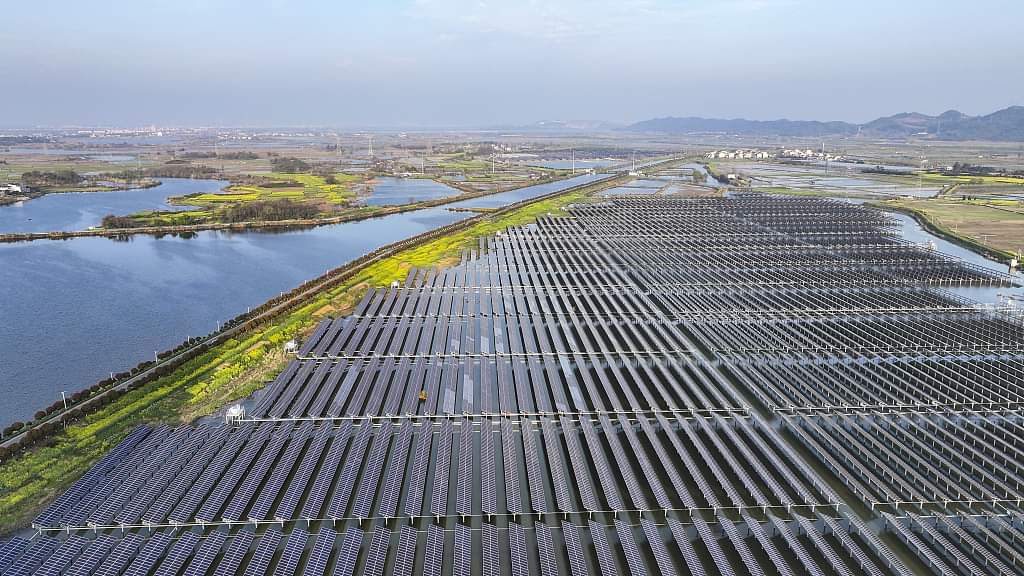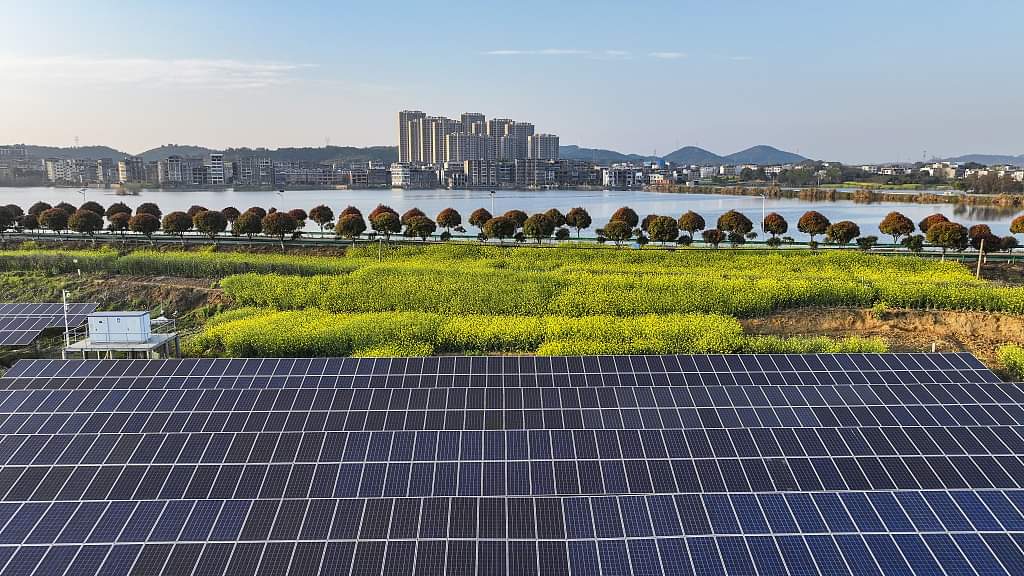 |
A Solar-Powered Symphony: Where Technology Meets Nature in China |
A Solar-Powered Symphony: Where Technology Meets Nature in China
Amidst the picturesque landscapes of Ruichang, East China's Jiangxi province, lies Anding Lake, a place where the future gleams brightly alongside tradition. Here, a unique experiment in sustainable living is playing out, showcasing a remarkable coexistence between a photovoltaic power station and a thriving fish farm.
Imagine rows upon rows of shimmering solar panels lining the banks of the lake, their surfaces capturing the sun's rays and converting them into clean, renewable energy. This is the photovoltaic power station, a marvel of modern technology humming efficiently. But look closer, and you'll see that the story doesn't end there.
Beneath the vast expanse of the solar panels, a network of fish farms flourishes. Here, in the dappled sunlight filtering through the panels, fish thrive in a carefully monitored environment. The innovative design of the power station provides partial shade, creating ideal conditions for certain fish species.
This harmonious blend of cutting-edge technology and natural resources is a testament to China's commitment to sustainable development. The photovoltaic power station generates clean energy, reducing dependence on fossil fuels and mitigating climate change. At the same time, the fish farms continue to produce a valuable source of food, ensuring a thriving local industry.
The coexistence of these seemingly disparate elements creates a beautiful synergy. The solar panels provide much-needed shade for the fish, while the fish farms contribute to a balanced ecosystem within the lake. This innovative project serves as a model for sustainable development around the world, demonstrating that progress and nature can coexist in harmony.
The story of Anding Lake is a testament to human ingenuity and our ability to find solutions that meet our needs while preserving our planet. It's a vision of a future where technological advancements complement the natural world, creating a sustainable and prosperous tomorrow.
The Anding Lake Project: A Look Under the Surface
The ChinaCanvas at Anding Lake goes beyond the idyllic picture it presents. Let's delve deeper into the intricacies of this project and explore some potential challenges and opportunities:
Challenges
Balancing Sunlight: While partial shade can benefit some fish species, ensuring enough sunlight reaches the water remains crucial for overall ecosystem health. Careful planning and design are needed to strike the right balance.
Impact on Birdlife: Solar panels can disrupt the natural habitat of birds that rely on the lake. Mitigating strategies like creating nesting areas outside the panel zone are essential.
Maintenance and Upkeep: Maintaining both the solar panels and the fish farms requires specialized expertise and resources. A skilled workforce is necessary to ensure the project's long-term viability.
Opportunities
Aquaponics Integration: Introducing aquaponics systems could create a closed-loop ecosystem. The fish waste from the farms could provide nutrients for plants grown under the solar panels, further optimizing resource utilization.
Biodiversity Enhancement: Planting native vegetation around the perimeter of the project can create corridors for wildlife, promoting biodiversity and fostering a healthy ecosystem.
Research and Development: The Anding Lake project serves as a living laboratory. Studying the interaction between the solar panels and the fish farms can provide valuable insights for replicating and improving this model in other locations.
The success of the ChinaCanvas hinges on continuous monitoring, adaptation, and innovation. By addressing potential challenges and exploring new opportunities, the project can become a beacon of sustainable development, fostering a future where clean energy production and ecological well-being go hand in hand.
Beyond Anding Lake: The Ripple Effect of ChinaCanvas
The ChinaCanvas project at Anding Lake is a pioneering example, but its significance extends far beyond its picturesque location. Here's how this innovation has the potential to create a ripple effect across China and the globe:
Replication and Expansion: The success of Anding Lake can serve as a blueprint for similar projects across China's vast freshwater resources. Integrating photovoltaic power stations with existing or new fish farms could become a widespread practice, contributing significantly to China's clean energy goals and sustainable food production.
Knowledge Sharing and Collaboration: China's expertise in this unique model can be shared with other countries. International collaboration on research and development can further refine the ChinaCanvas concept, leading to adaptations suitable for diverse geographical and ecological settings.
Boosting Sustainable Tourism: The Anding Lake project holds immense potential for eco-tourism. Tourists drawn to sustainable practices can visit the site to learn about the coexistence of technology and nature. This can raise awareness about environmental issues and inspire similar projects around the world.
Challenges and Considerations
While the prospects are exciting, replicating the ChinaCanvas model elsewhere requires careful consideration. Environmental impact assessments are crucial to ensure the project integrates seamlessly with the local ecosystem. Additionally, social factors like the needs and concerns of local communities must be addressed to ensure the project benefits all stakeholders.
A Model for the Future
The ChinaCanvas project is a significant step towards a more sustainable future. It demonstrates the possibility of marrying technological advancements with environmental responsibility. By learning from the Anding Lake project and adapting it to different contexts, we can create a future where clean energy production and environmental well-being thrive together, paving the way for a harmonious relationship between humankind and nature on a global scale.





